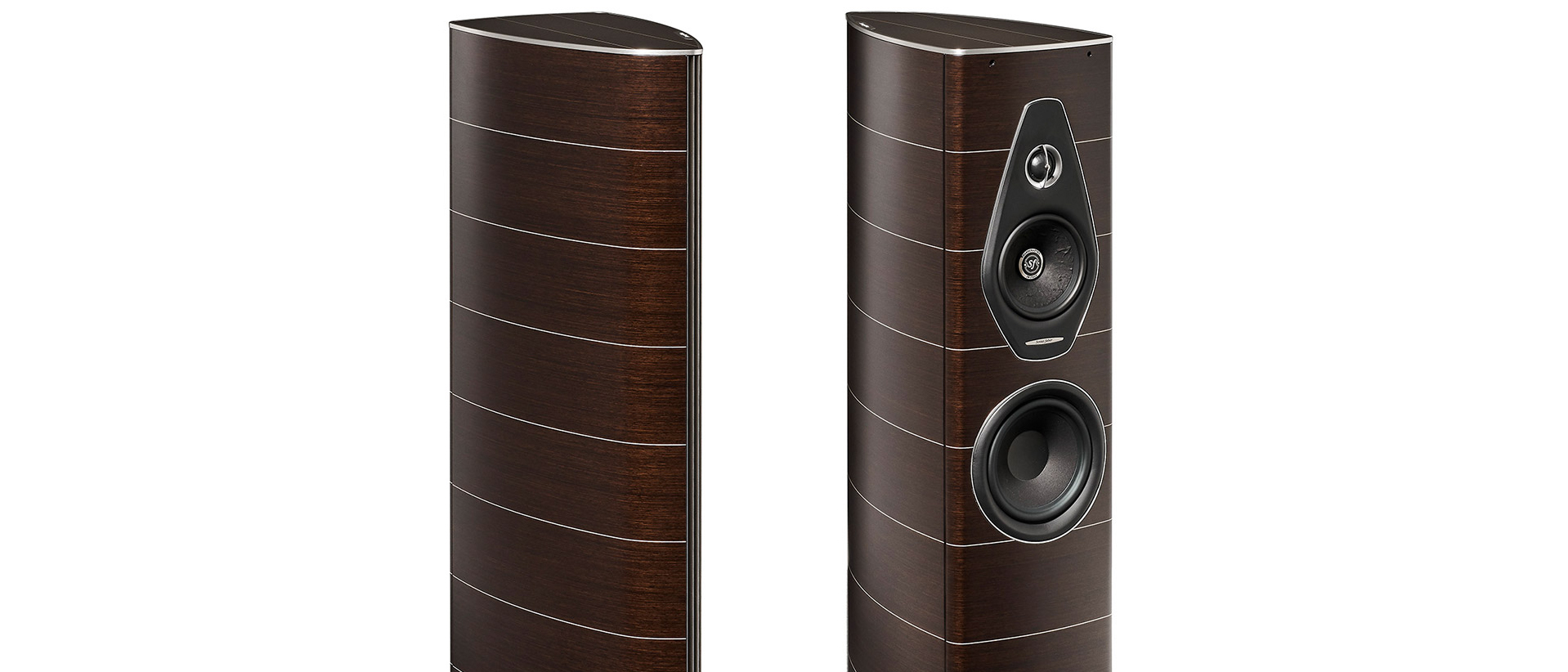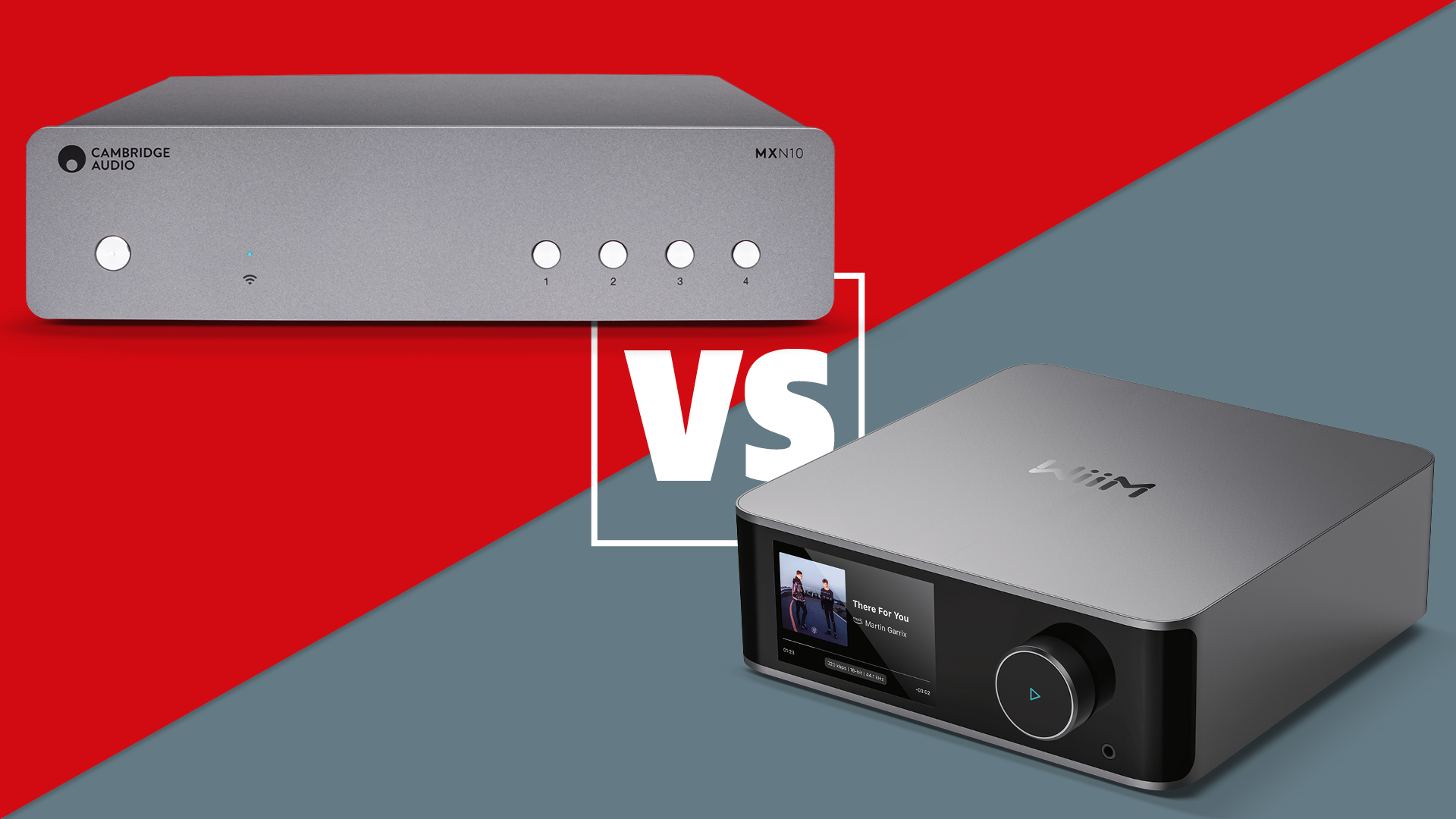What Hi-Fi? Verdict
For their modest size, these floorstanding speakers from Sonus Faber offer rich, three-dimensional audio and do so in one of the classiest packages available.
Pros
- +
Superb highs
- +
Luxurious finish
- +
Enveloping sound
Cons
- -
Not entirely stable
- -
Lack of real grille
Why you can trust What Hi-Fi?
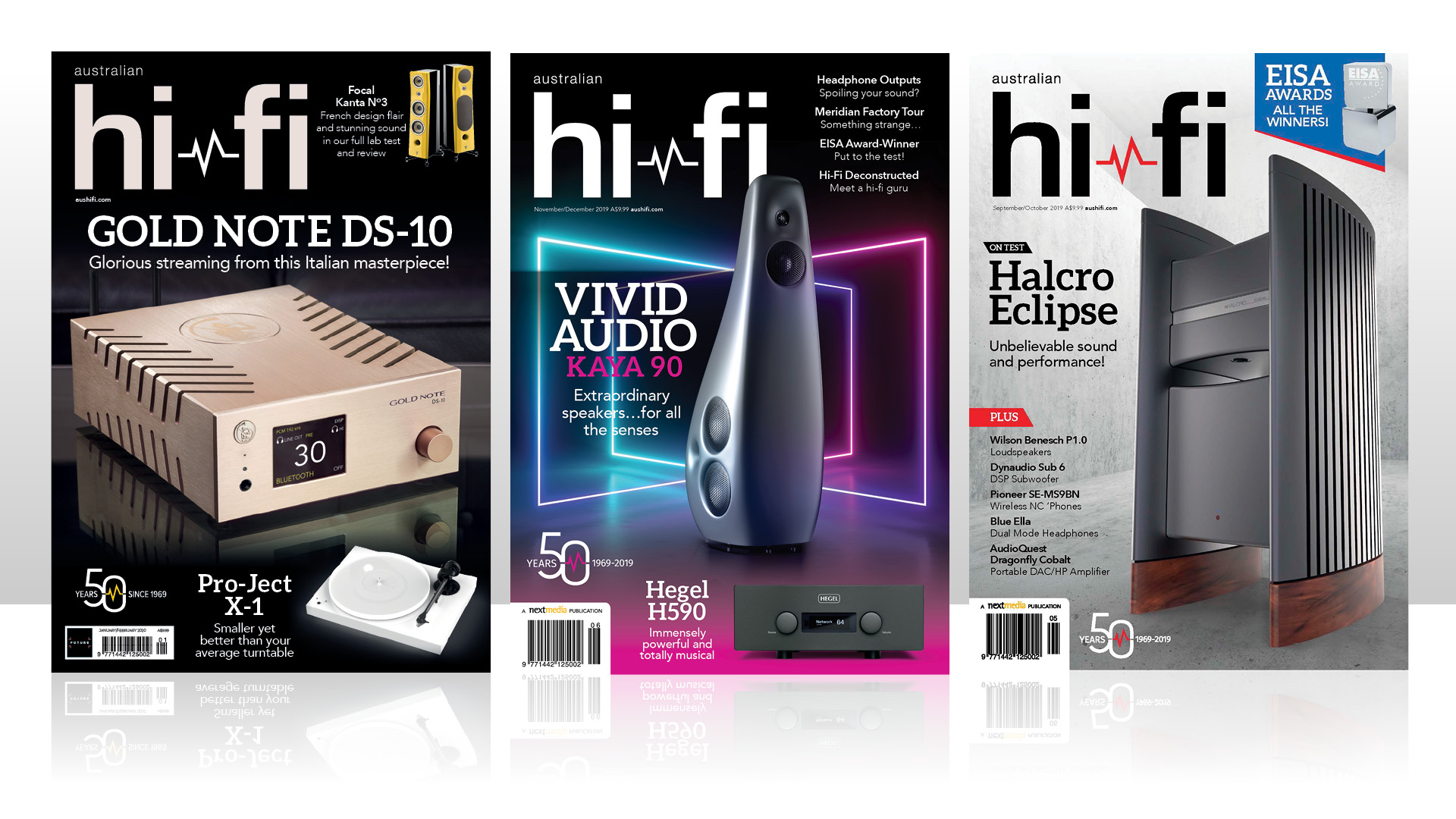
This review and test originally appeared in Australian Hi-Fi magazine, one of What Hi-Fi?’s sister titles from Down Under. Click here for more information about Australian Hi-Fi, including links to buy individual digital editions and details on how to subscribe.
Sonus Faber has used a rather unusual cabinet design for its Olympica Nova II loudspeakers. Whereas most loudspeaker designers opt for one of the two enclosure types whose physics are best-known – either a bass-reflex enclosure or a completely sealed enclosure – this Italian company uses an unusual ‘aperiodic’ enclosure for its Olympic Nova II… and it’s not even a ‘standard’ aperiodic enclosure, but an unusual variant of it which Sonus Faber calls ‘para-aperiodic’.
The Olympica Nova range replaces the long-running Olympica range, but in many respects, the two ranges have similar appearances and share similar technologies. This is precisely why Sonus Faber used the Italian word ‘nova’, which in English means ‘new’ to describe the range, so that in English, the model reviewed here would be the ‘New Olympica II’, but in Italian, it’s the ‘Olympica Nova II.’
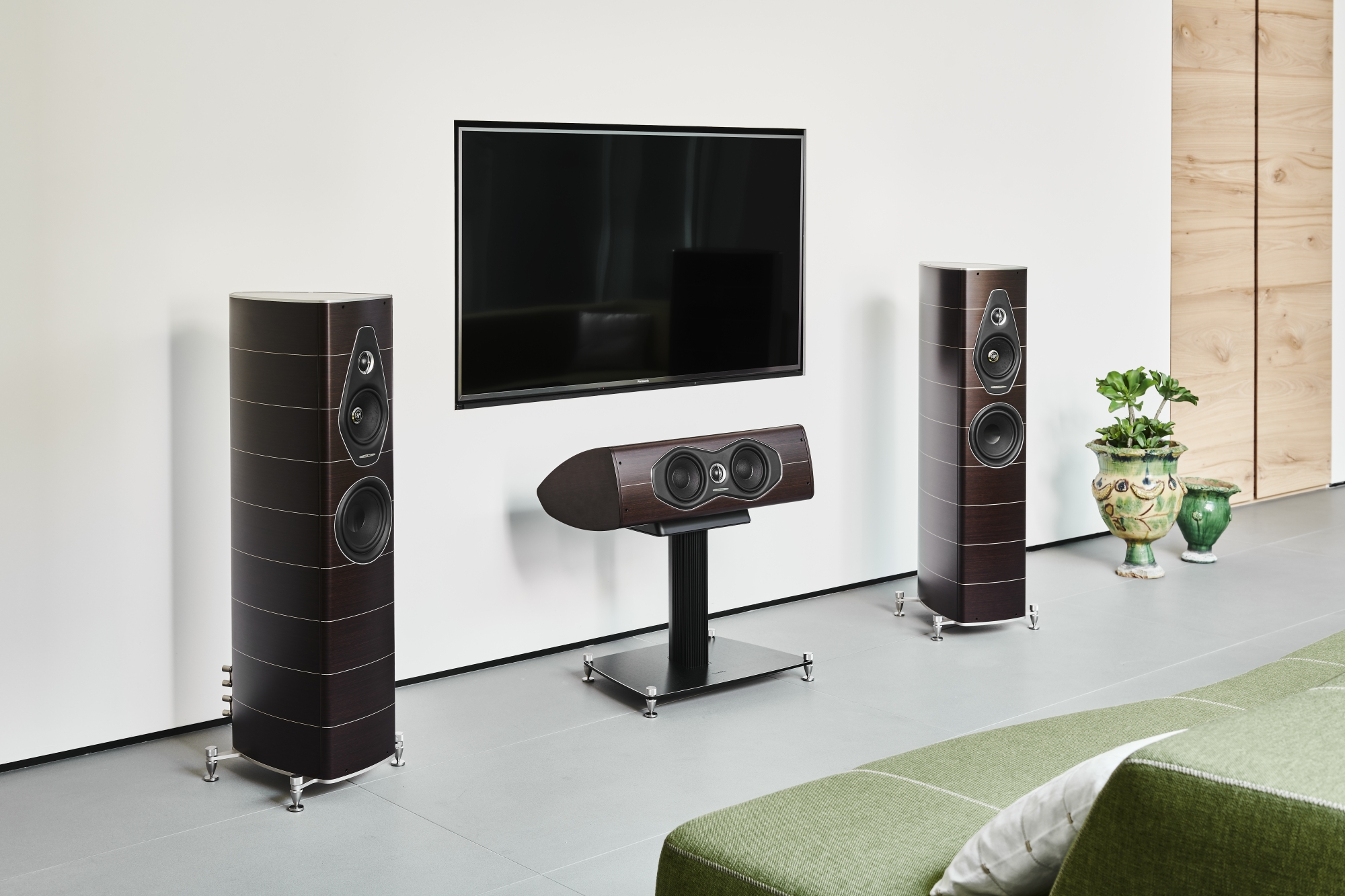
Equipment
Since one of the Olympica Nova II’s most defining design features is its para-aperiodic cabinet alignment, I think I should first address this alignment and its many advantages. But to do this, I need to recap the two most popular enclosure designs.
The sealed enclosure alignment is the most straightforward because it simply means that the cabinet into which the loudspeakers are installed is completely sealed: air cannot get into (or out of) the cabinet. This means that when, say, a bass driver’s cone goes ‘backwards’ into the cabinet in response to an audio signal, the air inside the cabinet is compressed. When the cone moves outwards, the air inside the cabinet is rarefied.
Depending on the size of the cabinet (and thus the volume of air inside it), it’s therefore possible to use the air as a ‘spring’ to help control the cone’s movement, in which specific case the alignment is called ‘acoustic suspension’. In much larger cabinets, where the volume of air inside is too large to act as a spring, the alignment is called ‘infinite baffle.’
In a bass-reflex alignment the enclosure containing the speakers is not sealed at all. Instead, a fairly sizeable hole (usually circular, which is why it’s often referred to as a 'port' - presumably a shortening of the nautical term for the round window in a sailing vessel, i.e. a ‘porthole’) is cut into the baffle or the rear of the cabinet, to which a hollow tube is attached.
In this arrangement, when a bass driver’s cone moves backward into the cabinet, air is forced out through the port and when the cone moves outwards, air is pushed into the cabinet by virtue of the air in the room being at a higher pressure than the air inside the cabinet.
Which brings us to the ‘aperiodic’ cabinet design. Essentially, it’s half bass-reflex and half infinite baffle, because although the aperiodic enclosure has a port, it’s always blocked in such a way as to partially prevent air from flowing through it. (Indeed some unkind speaker designers have been known to refer to aperiodic cabinets as ‘leaky boxes’.)
If putting a port in an enclosure only to then block it up sounds like a strange idea to you, I can assure you that it was even stranger when it was first proposed by none other than the famous British speaker designer Edward (Ted) Jordan (1929–2016) whose legacy continues on with the eponymous company he established (E. J. Jordan Designs).
What wasn’t so strange was that it was proposed by Jordan in the first place, because he was always exploring avenues that other designers completely ignored: one of his favourite sayings was "don’t follow the sheep". It was precisely by not following the sheep that Jordan was able to pioneer the development of metal-coned (titanium and alloy foil) drivers when he was working at Goodmans at a time when all other manufacturers were making cones from paper.
Jordan developed the aperiodic enclosure as a means of obtaining the greatest bass extension, smoothest frequency response and lowest distortion whilst using the smallest possible cabinet. Its first implementation was with a Goodmans Axium 150 Mk II bass driver in a cabinet fitted with a device that Jordan called an Acoustic Resistance Unit, or ‘ARU’, which allowed the cabinet to ‘leak air’.
Obviously neither this name nor its abbreviation ever actually caught on in the audio industry (possibly because it was trademarked by Goodmans), so these days similar ‘leaky’ devices are usually referred to as ‘resistive ports’ or ‘acoustic resistors’. As it happens, various other companies have followed in Goodmans’ footsteps by electing to trademark alternative names for the resistive port, two of the best known being ‘Variovent’ (trademarked by Dynaudio) and ‘Flow Resistance Vent’ (trademarked by ScanSpeak).
If right about now some of our more technically-minded readers are thinking that an aperiodic enclosure bestows most of the same advantages as a transmission line enclosure (none of the ringing and resonance effects of ported enclosures and none of the pressure effects of sealed enclosures) they’d be correct, though with the caveat that whereas transmission lines roll off at 12dB/octave below resonance, aperiodic enclosures roll off at 18dB/octave (and bass reflex enclosures roll off at 24dB/octave).
As for Sonus Faber’s ‘para-aperiodic’ enclosure, I can only assume that it is either ‘leakier’ or ‘less leaky’ than a conventional aperiodic enclosure, and my guess, after listening to it, is that it’s leakier (leaning more towards a bass reflex alignment than a sealed alignment).
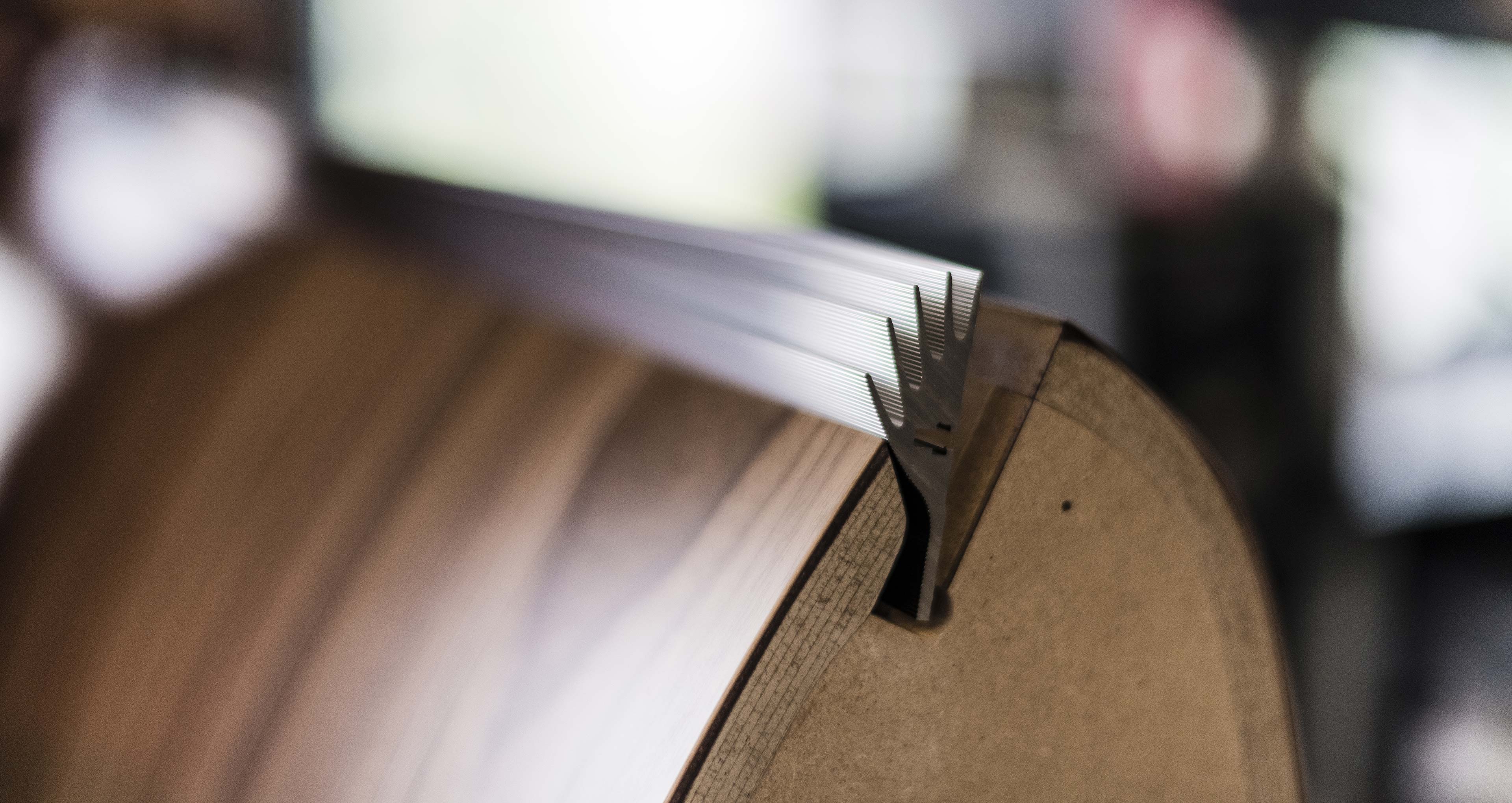
Sonus Faber appears to call its resistive port a ‘Stealth Ultraflex’ port and on the Olympica Nova II it’s implemented as a section of aluminium extrusion fitted to the rear of the cabinet that extends the cabinet’s entire height. It looks rather like a long heat sink, due to the multiple wave-shaped fins. Between two of these fins is a slot that acts to vent the interior air volume of the cabinet.
The ‘ports’ are not centred at the rear, which means that each speaker is a mirror-image of the other, rather than being identical. Sonus Faber suggests that this enables users to experiment with speaker positioning, by either having the ports vent inward, towards each other, or outwards towards the sidewalls, to see which alignment delivers the best bass in your listening room.
As you can see from the photographs accompanying this review, the Olympica Nova II is a three-way design. The bass driver is a Sonus Faber Type W18XTR2-08 that’s rated with a ‘nominal’ diameter of 180mm but this is a bit deceptive because it’s the measurement of the overall diameter of the driver chassis – and the edge (or ‘lip’) of the chassis of this particular driver is a good deal larger than usual – which means the actual cone diameter is only 118mm and the Thiele/Small diameter is 130mm, for an Sd of 133cm².
Because Sonus Faber takes such pains to emphasise that the midrange driver of the Olympica Nova II is made entirely in-house, I can only assume that the fact it also takes pains to specifically state that only cones of the bass driver are ‘Made in Italy’ means that the motor and chassis are not. As for that ‘Made in Italy’ cone, I am reliably informed that it’s made from two layers of cellulose pulp between which is a layer of syntactic foam – a cone construction technique that’s become almost de rigeur for bass drivers used on a great many high-end loudspeakers, most famously those from B&W (Aerofoil) and Focal (‘W’).
Sonus Faber says that the 150mm diameter midrange driver (15 XTR2-04) it uses in the Olympica Nova II is built completely in-house in Italy by Sonus Faber itself. Although it’s rated with a nominal diameter of 150mm, the cone itself is only 100mm in diameter and is made entirely of air-dried, non-pressed natural fibres, including cellulose, Kapok and Kenaf.
Because the cone is not pressed while it’s drying, the surface of the cone is neither smooth nor uniformly dense – nor indeed, uniformly thick– so to the eye, it doesn’t look like a ‘manufactured’ product at all… in fact it looks positively hand-made. Sonus faber says that building the cone in this way reduces cone resonances which it claims "guarantees a natural sound with increased transparency and greater detail". The central dustcap is a hard material into which is moulded the famous ‘Sf’ logo along with the words ‘Handcrafted in Italy’.
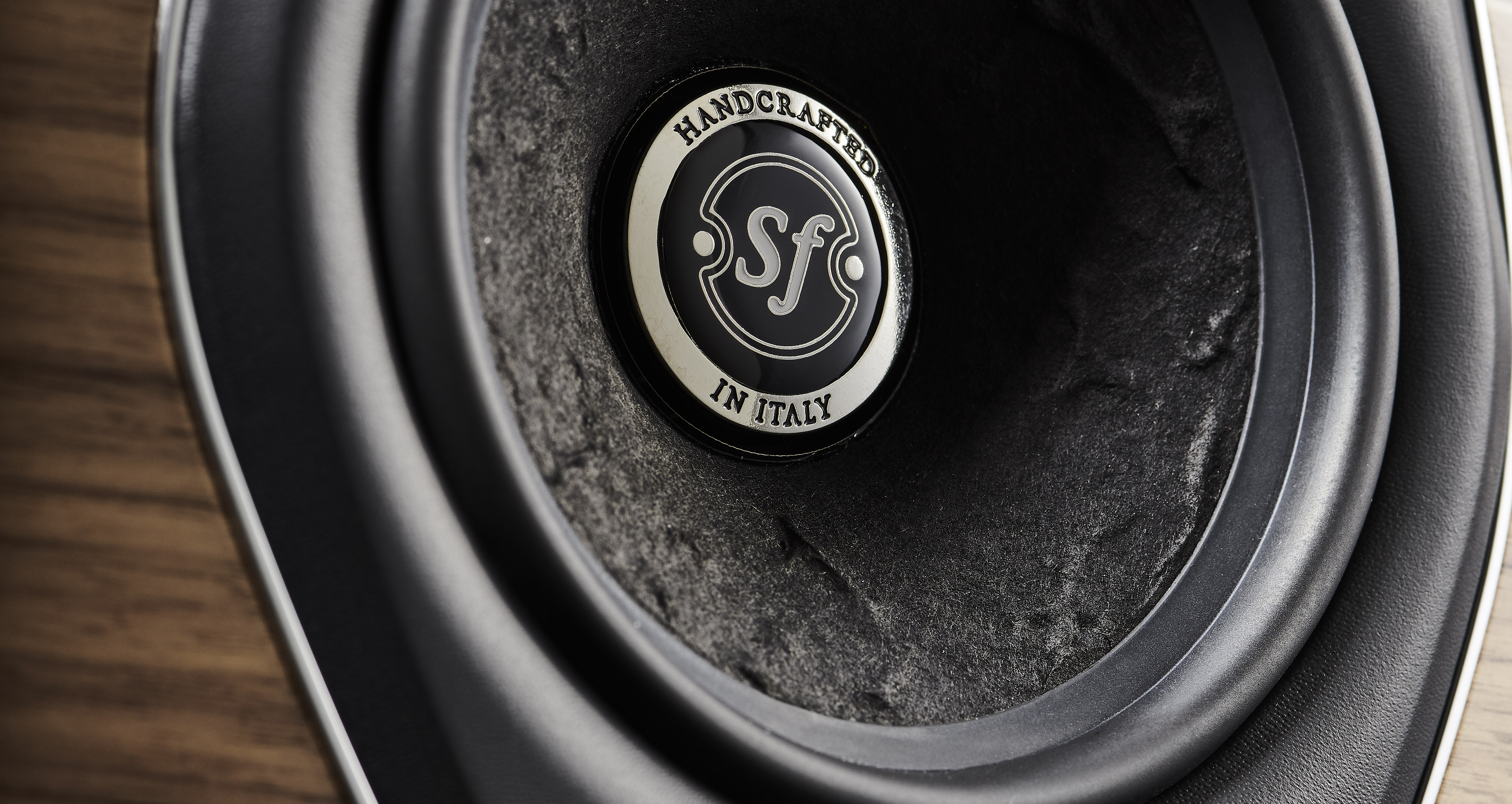
And just in case you were looking at the names of the fibres used to form the cone and were wondering what ‘kenaf’ might be, its botanical name, hibiscus cannabinus, should give you a very good clue about this particular ingredient! As for kapok, it’s a fine, fibrous substance rather like cotton that grows around the seeds of the ceiba pentandra tree. The voice coil of this driver is made from aluminium wire with a copper coating (a combination that’s designed to combine high conductivity with low mass).
The tweeter in the Olympica Nova II is an H28 XTR3 DAD soft-dome type. The ‘28’ in the model number indicates that the tweeter is 28mm in diameter, while the DAD stands for ‘Damped Apex Dome’. What’s a damped apex dome? Whenever the dome of a soft-dome tweeter moves forward, the highest point of the dome (which Sonus Faber refers to as the ‘apex’) tends to ‘crumple’ inwards due to air pressure. This means that the movement of that particular bit of dome fabric is not only non-linear, but also out of phase, which causes the high frequencies to roll off prematurely.
Sonus Faber’s solution to prevent this from happening is to add what it calls ‘local dampening’ via a small bridge across the dome, at the centre of which is a backwards-facing cone. This structure is quite visible on all Sonus Faber tweeters incorporating DAD technology.
This tendency for the dome of a soft dome tweeter to deform as it moves forward is one reason why many loudspeaker manufacturers use tweeters with hard domes – usually a metal or a ceramic, but increasingly now, beryllium or diamond. Unfortunately, hard domed tweeters have problematic issues of their own, the most common of which is a hard-to-control high-frequency resonance, the exact frequency of which varies according to the material being used.
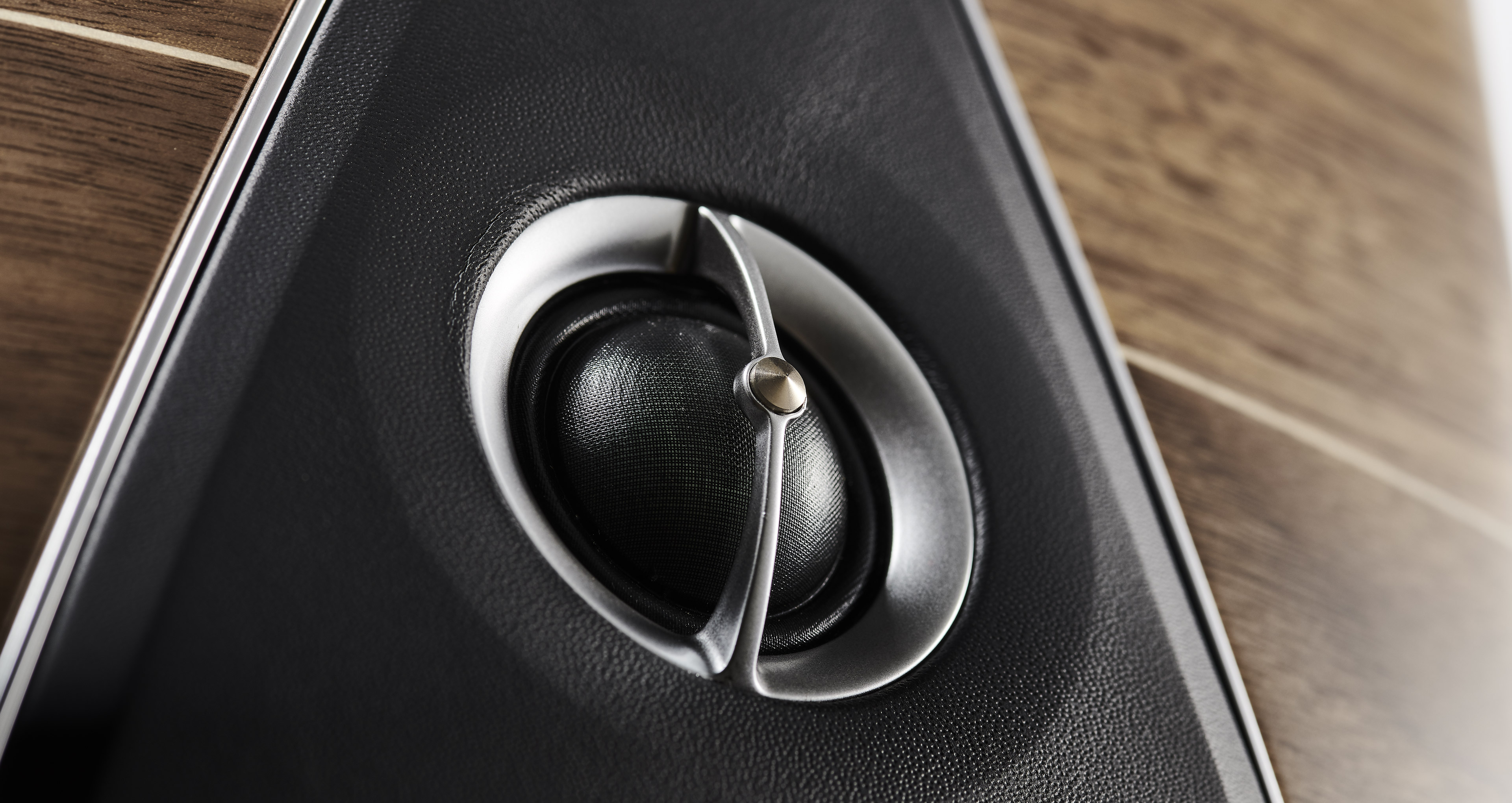
The midrange and tweeter are housed on a separate ‘plate’ that is covered in black leather. Exactly the same plate is used for four models in the Olympica range, the Nova I, Nova II, Nova III and Nova V, and a variant of the same plate is used on the two centre-channel models, CI and CII, as well as on the Nova WI, which is a surround speaker. What happened to the Nova IV? My guess is that this ‘missing link’ in the Nova series will be filled later this year.
The three-way crossover network used in the Olympica Nova II has nominal crossover points at 250Hz and 2.5kHz, with all the components required to accomplish this being mounted on a single-layer printed circuit board. These components include air-cored and ferrite-cored inductors, all cross-mounted to eliminate magnetic interaction, high-quality wirewound resistors and, for the first time, capacitors custom-made for Sonus Faber by UK capacitor specialist Clarity Cap.
Sonus Faber says that in accomplishing the required crossover frequencies and roll-off slopes, it uses a component layout topology it calls ‘Paracross’ that it claims ‘makes the crossover less sensitive to radio-frequency interference’ which in turn has the result of, in the company’s words, "improving transient response and lowering noise floor". As for how the circuit differs from conventional crossover topologies, I was told that it involves "re-wiring a capacitor from one 'side' of a driver to the other side, so that it shares the ground connection with the shunt inductor".
I rather hope that you will be able to see from the photographs of the Olympica Nova II cabinet that will accompany this review the cabinets’ rather odd shape – more triangular than anything else, and that the wooden side panels are curved. The ‘curves’ are achieved using the same technique that’s used to build modern wooden yachts, where multiple layers of thin wood bonded together with adhesive. And, as with those yachts, Sonus Faber has also used internal ribbing both to add strength and reduce resonances.
At the top and bottom of the cabinet are diecast aluminium plates which serve to lock the entire structure together, but the one at the bottom is also the central point for the four ‘outrigger’ feet that make these tall speakers steadier and more stable than they’d be if the feet were contained within the footprint of the cabinet. Although these feet do their practical job admirably, I have yet to be convinced as to whether they contribute positively to the Olympica Nova II’s otherwise admirable aesthetics.
The bi-wirable speaker terminals are very obviously custom-made, with the shape of the cabinet making the vertical orientation of the four terminals the only viable option. The terminals have a nice ‘knurl’ that I initially imagined would make them easy to tighten… and indeed they are easy to tighten if your speaker wires are terminated in spades or pins, but strangely enough I found it quite difficult to tighten the terminals over bare speaker wire. In the light of this, I would suggest you terminate your speaker cables in that easiest termination of all (and my personal fave), the banana plug!
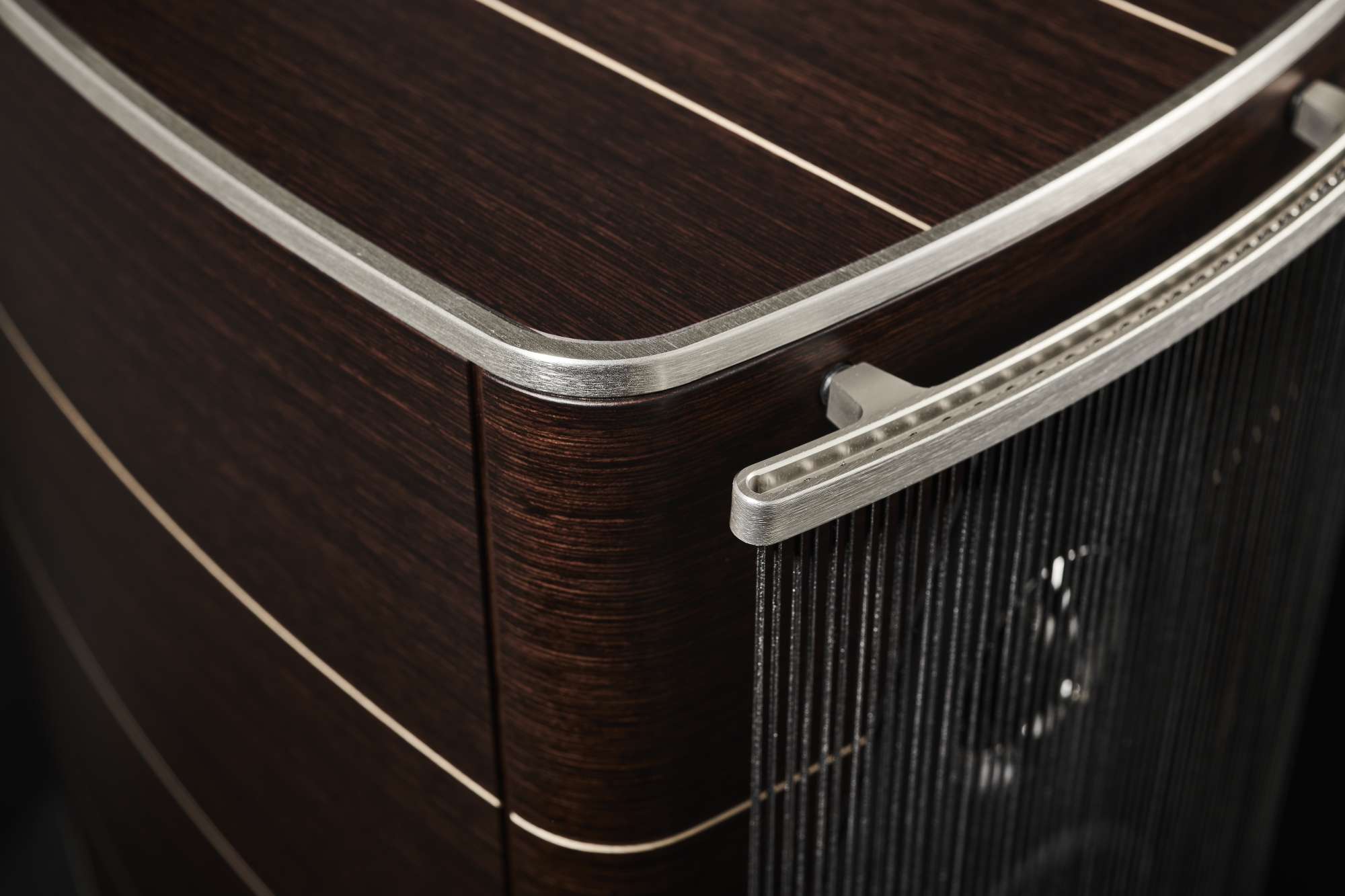
As with all Sonus Faber speakers, the Olympica Nova II does not have a ‘grille’ as such, though as you can see from the photographs, it most certainly does have a ‘grille’. What you may not be able to see from the photographs is that the ‘grille’ is actually a large number of individual elastic cords that are kept taut and in position by two metal bars that attach to the baffle (or not, if you choose not to fit them).
Although this ‘grille’ looks absolutely superb, it does not really fulfil the traditional role of a loudspeaker grille, which is to protect the drivers from dust and from ultra-violet radiation, as well as provide some physical protection for those drivers (against claws, poking fingers and such-like). What you can be absolutely sure of is that unlike a ‘traditional’ loudspeaker grille, which will always modify the frequency response and dispersion of the speaker to which it’s attached, Sonus Faber’s grille will have absolutely no effect on sound quality at all!
The Sonus Faber Olympica Nova II is a tallish loudspeaker (1037mm) and, due to its substantial construction, it’s also heavy, at over 30 kilograms. This means, despite the outrigger feet that give it an effective footprint of 360×423mm and increase its stability, it’s moderately easy to push over, which is something you should consider in relation to your own domestic situation in the event your family includes boisterous children... or pets.
So far as finishes are concerned, you have a choice of two real-wood finishes: Walnut or Wenge. Walnut is the lighter of the two finishes, and the one with which you’ll likely be most familiar. Wenge, a name with which you may not be so familiar, is the common name for the Millettia laurentii tree, whose wood was previously called African Rosewood.
Whatever finish you choose, you won’t be disappointed by the fit ‘n finish, because it’s outrageously good. The words ‘fine furniture’ are bandied around a lot when it comes to hi-fi loudspeakers, but close inspection usually reveals that they’re merely puffery. That’s not the case with the Sonus Faber Olympica Nova II cabinets. They’re extraordinarily well-finished: flawless in fact. I could only but marvel at the detailing, and the quality of that detailing. They are indeed ‘fine furniture’ pieces.
Listening
Positioning the Sonus Faber Olympica Nova IIs turned out to be an exercise in simplicity, because I just placed them where I place pretty much all floorstanding speakers in my listening room, with their backs a metre from the rear wall, and the speakers around 3 metres apart and angled in directly at my listening position, which is four metres distant from the baseline.
I’d actually asked a friend over to help with some fine-tuning and tweaking, but it turned out it wasn’t necessary because the minute the music started playing, it was obvious that the positioning was perfect, not least because the soundfield I experienced was virtually holographic from the outset, so that there was no way I could localise the sound as issuing from the speakers. It was as if the speakers didn’t exist, just the musicians.
I have experienced this before, of course, but rarely so perfectly from such large multi-driver loudspeakers, because a prerequisite for this level of performance is that the left and right speakers are perfectly matched, so this must certainly have been the case with my review pair. And by holographic soundfield, I am referencing not just the stereo imaging, but also the height and depth of the soundstage. It was the sonic equivalent of a hologram.
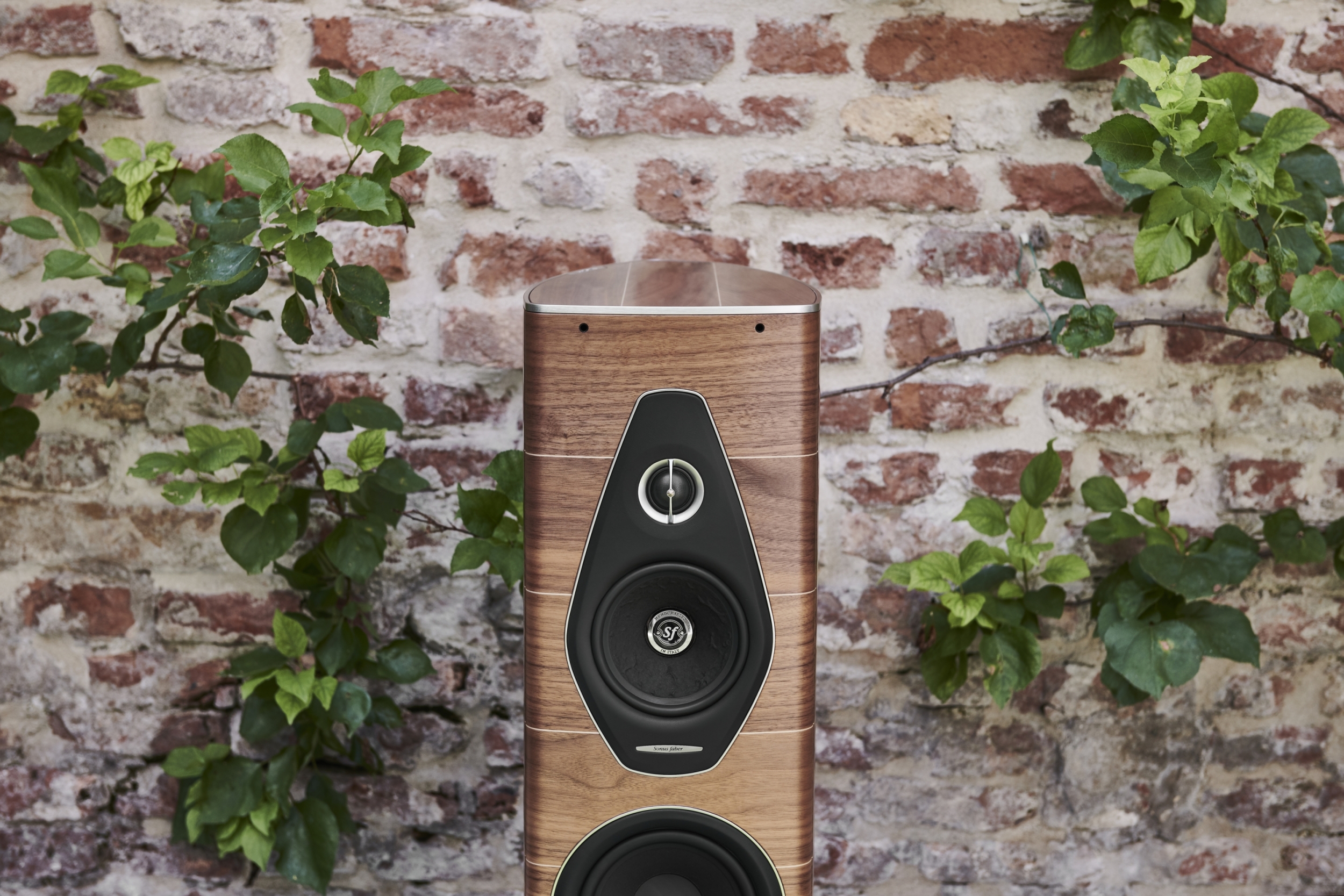
What I was playing was one of my favourite hi-res recordings – Janis Ian’s album Breaking Silence. It’s not my favourite album of hers, that would probably be Between The Lines which I actually purchased not because I liked Janis Ian... in fact I’d never heard of her back then... but because it was one of the very first CDs to be released, and I needed fodder to show off my new (and very expensive!) CD player. (FYI, having been unavailable for many years, it’s now available from www.janisian.com).
As I said, Breaking Silence is not my favourite album of hers, but I still like the songs, and the sound quality is amazingly good. It was recorded by Jeff Balding at Bill Schnee’s studio, after which Doug Sax worked on the final two-track master… yep, it was all analogue – in fact you can still get it on analogue (200g 33.33rpm LP, 2-LP 45rpm vinyl and even on reel-to-reel) – as well as on CD and SACD.
Right from the opener, All Roads to the River, it was as if two long warm arms of sound had wrapped around me. Immediately obvious was the fantastic bass playing of Chad Watson which underpins all the tracks on this album. Then there’s the beautiful interplay between the acoustic guitar and the electric, as they riff off each other, but also continuously interpose the same familiar motifs, sometimes played as individual notes, and at other times as chords.
The speed of the Sonus Faber Olympica Nova IIs’ delivery with the percussion was incredible. The click of Jim Brock’s drumstick on the snare rim is immediately real and totally present in the room. You’ll also hear the superior delivery of the Nova IIs in the clarity of Ian’s voice (particularly if you’re listening to a hi-res version), which Balding has captured immaculately.
Because Ian doesn’t have a stand-out vocal ‘tell’, I think her singing has been under-rated by critics over the years. Listen to her delivery on this track, where the vocal is forward, rather than a little back in the mix like it usually is, and you can hear not only the purity of her delivery, but also the way she’s able to inflect it without losing any pitching or timing.
Bass is a definite feature of Tattoo (Track 3) and Guess You Had To Be There and again the Sonus Faber Olympica Nova IIs delivered the bass with perfect depth and at exact pitch, and without over-egging it. Sonus Faber’s engineers have admirably resisted the temptation to build a bit ‘extra’ into the upper bass. I can see the attraction of doing this – a little forwardness in the bass makes a pair of speakers sound more impressive in showroom demos, whose rooms are usually much larger than typical lounge rooms, but quickly becomes obvious and tiring when you get the speakers home.
You can hear the precision of the Sonus Faber Olympica Nova IIs’ midrange sound on Walking On Sacred Ground, because Ian overdubbed the initial sound of the word ‘Walking’ in the choruses, and if a loudspeaker system doesn’t have a dedicated midrange driver, it’s difficult to distinguish the word, whereas the Olympica Nova IIs made the pronunciation crystal clear. The same effect is demonstrated when Ian sings the word without the overdub a few bars after, but at a quicker tempo, which on lesser speakers results in the word sounding like ‘wokking’ rather than ‘walking’. Once again, the Olympica Nova IIs’ delivery was spot-on.
The Sonus Faber Olympica Nova IIs’ high-frequency performance was beautifully demonstrated on This Train Still Runs, where the shimmer of the cymbals is as clear and sparkling as water over a cascade on a remote mountain.
Piano is a great revealer of loudspeaker tonality, and although there’s some piano on Breaking Silence (played by Ian herself) the first serious piano sounds I started listening to was Ray Kennedy Jr.’s fantastic pianism on the DSD version of John Pizarelli’s album Kisses in the Rain. Listening to From Monday On, I marvelled at Kennedy’s ability to alternate instantly between stabbing single keys then adding difficult high-speed runs so fluidly. I’d never seen him play (he died of MS, aged only 58) but you can hear that his fingering must have been fantastic.
The sound of the piano as reproduced by the Nova IIs was outstanding, helped by a typically professional Telarc recording. Then, listening to the way the Nova IIs handled the delivery of Pizarelli’s lead guitar break, I found the guitar’s sound biting and true, plus a great lead-in to Kennedy’s extended piano break, which follows.
The Nova IIs are certainly revealing because I was able to discern two tiny finger slips from Kennedy that I’d not heard previously. On the following track, When I Take My Sugar To Tea, the Sonus Faber Olympica Nova IIs delivered the sibilances of Pizzaralli’s singing very discreetly, without the ‘tizz’ I hear from speakers that use hard domed tweeters.
But I also wanted to hear the sound of a piano in a natural acoustic and without the distractions of other instruments and voices, so it was time to once again listen to The Köln Concert. I can’t say that the sound was like being there, but it was certainly the next best thing, and I took advantage of it to check the Sonus Faber Olympica Nova IIs’ tonal delivery over a range of volume levels.
Starting with whisper quiet and eventually moving up to levels louder than I’d ever use, even if I were alone in the house, the tone of the Olympica Nova IIs stayed identical, so there was no loss of detailing at low levels, and the sound did not harden up or become brittle at higher levels. All I was hearing was the Bösendorfer baby grand and the acoustic of the Köln Opera House.
Indeed at louder levels, that acoustic brought me even closer to what it must have been like on the night. I took advantage of the sustained piano sounds to move around to check the quality of the off-axis sound and was gratified to find that the tonal quality was as good off-axis as it was on. Obviously if I moved too far off-axis the sonic hologram disappeared, but the ‘sweet spot’ was satisfyingly large.
Interestingly, one of the reasons the sounds on this album are so sustained is because Jarrett was trying to make the baby grand sound more like the Bösendorfer Model 290 Imperial he’d expected to be playing but due to a mix-up had not been delivered. You can hear the jangly sounds as the recently-tightened strings loosen under the hammering they get from Jarrett, and the Nova IIs accurately reveal how the tuning gets even worse as the evening progresses. I love this piano. It reminds me of the one that Glenn Gould loved playing specifically because it was, he said, "a neurotic piano that thinks it’s a harpsichord".
I tried out the Olympica Nova IIs deeper bass regions with my favourite version of Bach’s Toccata and Fugue in D Minor, which is played by Robert Noehren on the Rieger organ at the Pacific Union College Church in the Napa Valley. This fabulous instrument was built in Schwarzach, Austria, and has 4,000 pipes ranging in size from two inches to 20 feet, 58 stops, eight couplers and eight combination stops. Its unusual position at the front of the church came about because the designers worried that if it were placed at the rear, it would cause the balcony to shake sufficiently to damage it.
Listen to the low Ds as reproduced by the Olympica Nova IIs and you’ll easily be able to understand the reason for their fears. John Eargle’s recording (for Delos) captures the sound perfectly. There are bigger organs around, but this sonic balance of this Rieger is, for me, ideal. It’s the most beautiful-sounding instrument I’ve heard.
Of course the Olympica Nova IIs do not deliver the low organ notes with full force – even reproducing the lowest piano notes is a bit of a stretch for these speakers – but since few if any instruments have fundamentals as low as those even on a piano, and the Nova II’s deliver satisfyingly hard-hitting bass from kick drum and the open low strings on electric and acoustic bass, I was more than happy.
I thought I’d give the high-frequency performance of the Sonus Faber Olympica Nova IIs another try with Andy Summers’ Earth + Sky, which is notable for its too-closely miked cymbals on Vinnie Colaiuta’s kit, which means that on lesser systems their sound tends to blur into white noise, and was pleased to find my earlier assessment of the high-frequency delivery when listening to Pizarelli was accurate, because the sound was delivered oh-so-sweetly by the Nova IIs’ apex-damped soft-dome tweeters.
Final verdict
Sonus Faber’s Olympica Nova IIs are classy speakers, in the very nicest sense of that word. I don’t think you will find any other pair of speakers that will look better in your living room (unless it’s another pair of Sonus Fabers), and their sound quality is everything you could want – and more – from such modestly-sized cabinets.
Lab test results
Newport Test Labs measured the overall frequency response of the Sonus Faber Olympica Nova II design as 38Hz to 37kHz ±4dB, which is an excellent result, and one that appears to be somewhat better than that claimed by Sonus Faber itself. However, since the company’s specification (of 40–35,000Hz) doesn’t actually specify the amount in decibels that the response deviates over this frequency range I cannot be absolutely certain of whether it does or not.
However that lower limit of 40Hz would suggest to me that it was obtained anechoically, whereas Newport Test Labs’ measurement was obtained in a real room, and of course bass will always get a boost in a room due to room gain, just as the bass response you achieve in your own room will be largely dependent on where you position your loudspeakers in it.
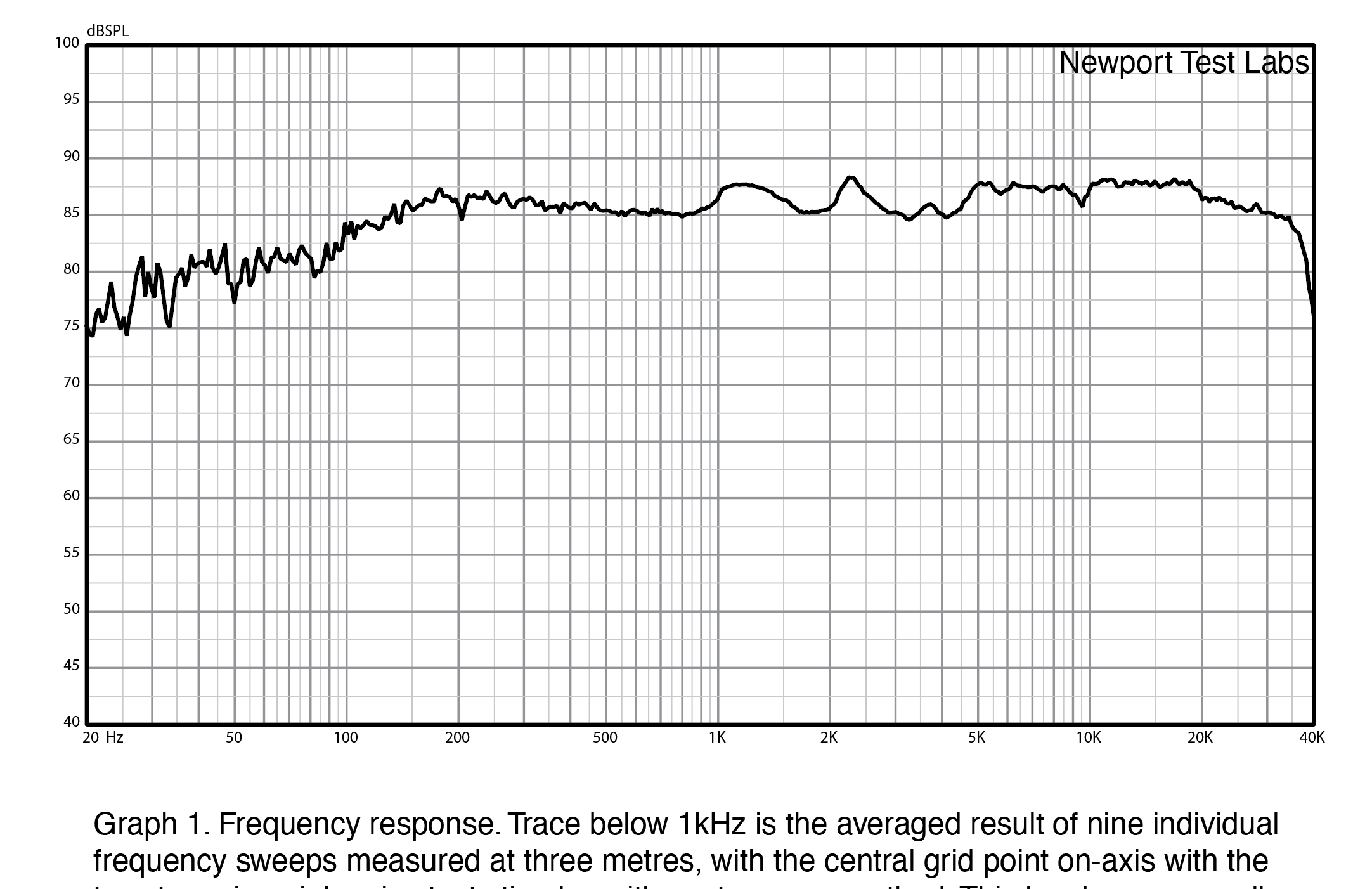
You can see from Graph 1 that the overall frequency response is not spectrally skewed, though overall, the average level of the response above 1kHz is around 2dB higher than the average level below 1kHz, so I would not expect the speaker to sound totally neutral. And although the frequency response between 140Hz and 30kHz is within 2dB of reference, I would expect to hear some effects from the noticeable anomalies visible in the response at 1–1.5kHz and particularly at 2.3kHz.
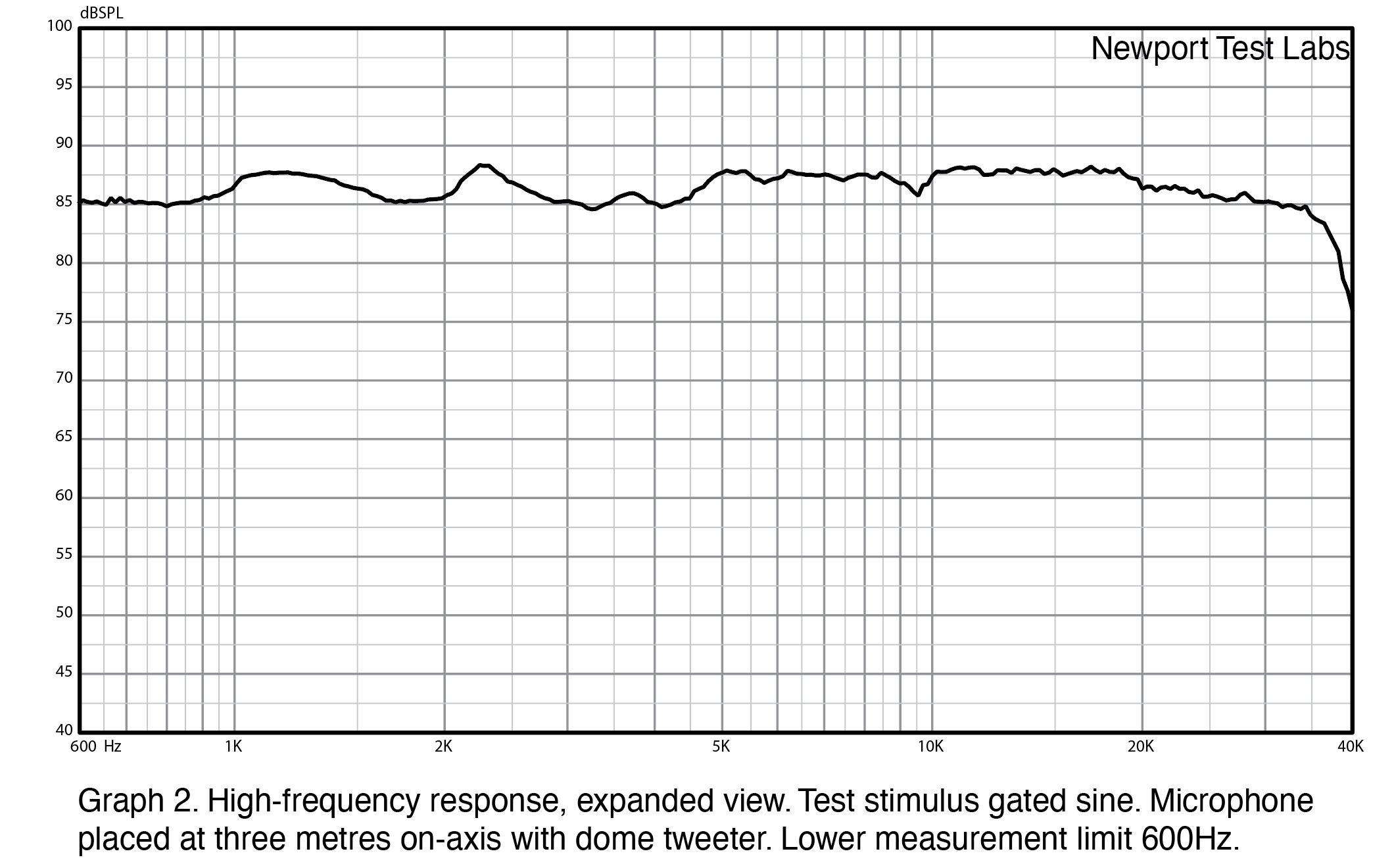
A magnified view of the Sonus Faber Olympica Nova II’s high-frequency response is shown in Graph 2, and you can see that the tweeter’s response, in particular, is outstandingly flat and extended. You can see that from 5kHz upwards it hugs the 87.5dB graphing line except for a tiny notch at 9.5kHz right out to 20kHz, after which there’s only a slow roll-off to 35kHz, followed by a sharper roll-off to 40kHz.
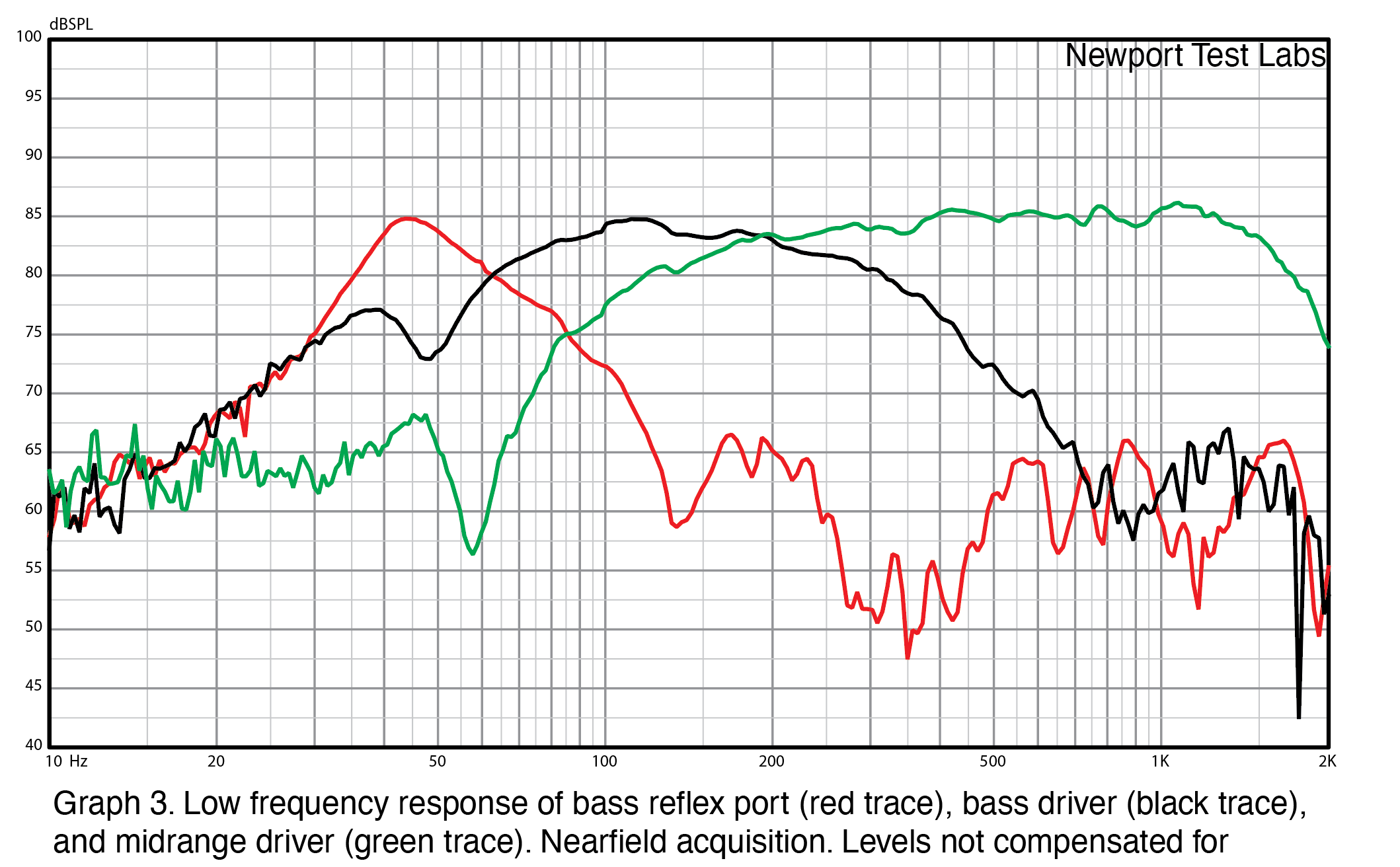
Graph 3 shows the low-frequency response of the Sonus Faber Olympica Nova II, which Newport Test Labs measured using a technique that delivers what is essentially an anechoic response… one that would be obtained in an anechoic chamber.
Without any room reinforcement you can see the low-frequency roll-off of the Nova II’s bass driver starts fairly early, beginning at 100Hz, and reaches its minima at around 48Hz. The output of the port peaks a little lower, at 44Hz, and its Q is so high that it contributes bass over the relatively narrow range of around 32Hz to 85Hz.
Interestingly, it would appear that Sonus Faber is not filtering the low-frequency response of the midrange driver. It appears the company is trying to extract more bass by using its output to add to that of the bass driver.
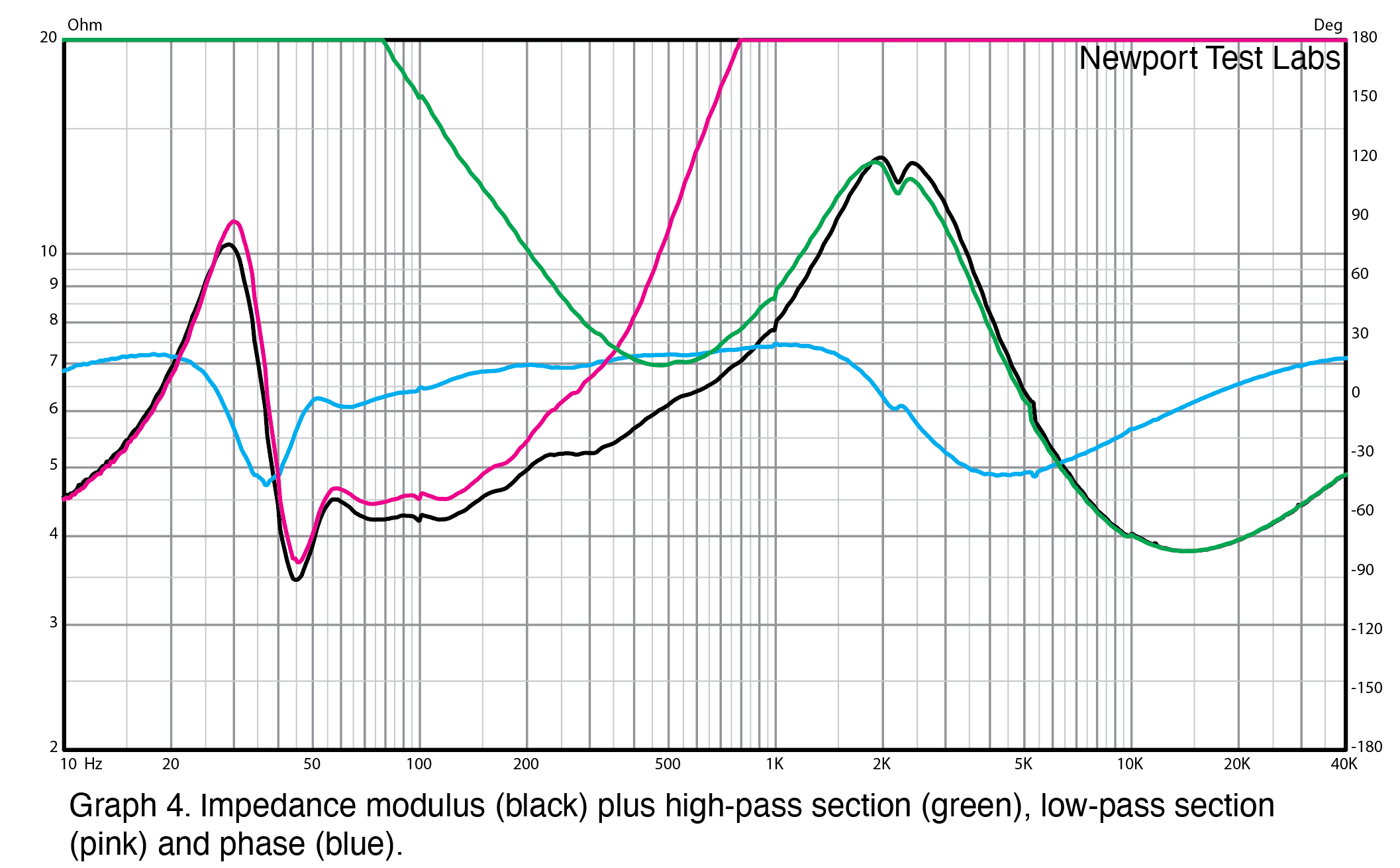
The measurements of impedance made by Newport Test Labs (Graph 4) show an overall controlled impedance that mostly hovers between 4Ω and 8Ω, with a very sharp dip at the port’s resonant frequency to just 3.5Ω, so the Olympica Nova II is most definitely nominally a 4Ω design.
You can see that the electrical crossover point between the high and low-pass sections is at 350Hz and the phase angle is largely benign, though the combination of the lowish impedance (4.8Ω) and –50° phase angle at around 38Hz would seem to suggest that it would be best to partner the Nova IIs with a high-power, high-current amplifier.
Perhaps what is most interesting about Graph 4 is the very obvious resonances it reveals, particularly at 2.3kHz, but also at 5.2kHz and 38Hz. (What appear to be resonances on the traces at 100Hz, 1kHz and 10kHz are actually range-switching artefacts caused by the test equipment, and should be ignored.)
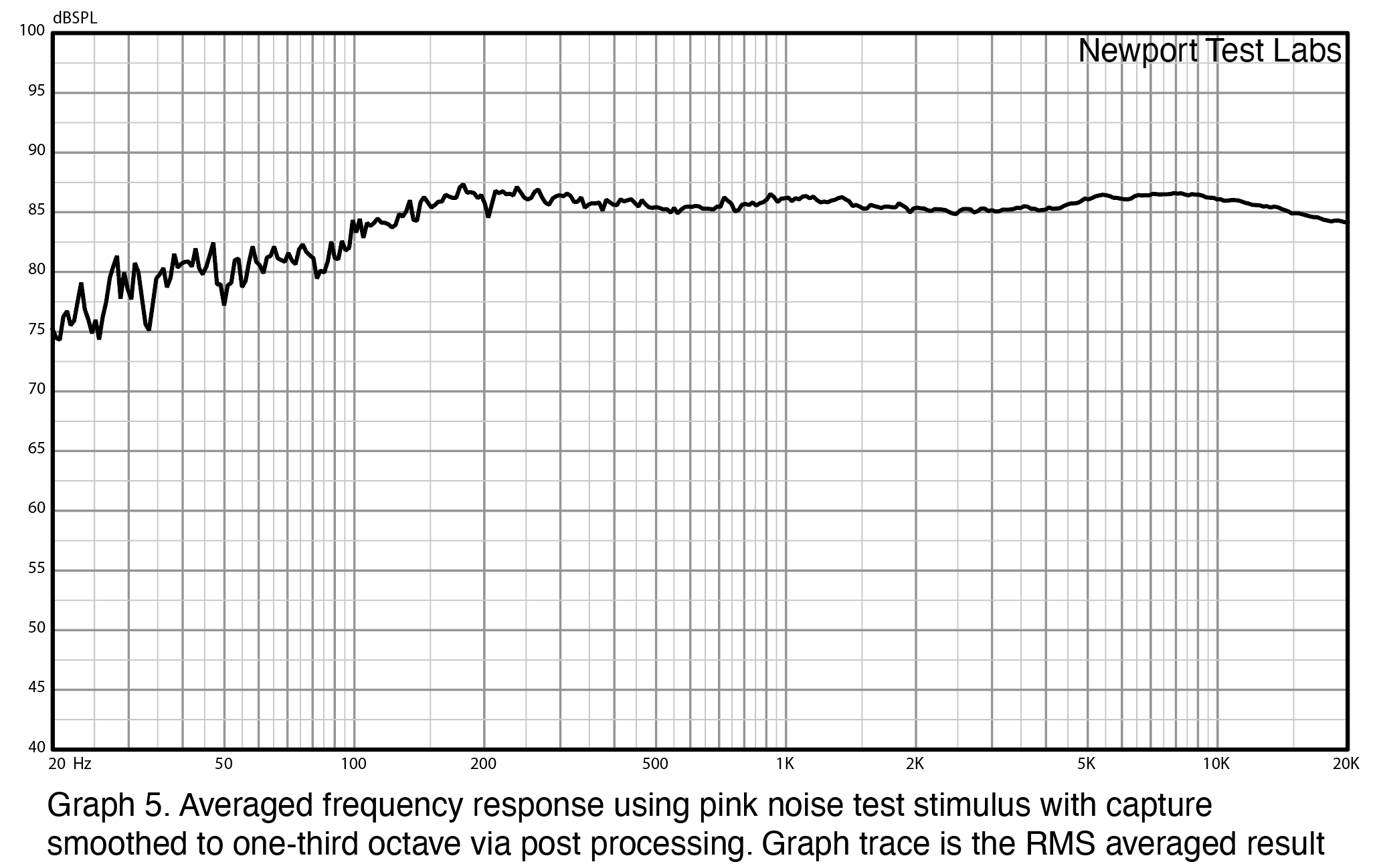
Graph 5 shows a band-limited in-room one-third octave frequency response for the Olympica Nova II and you can see the third-octave smoothing effectively removes the peaks in the high-frequency response that were visible on Graphs 1 and 2, so this is the response that would be perceived by the human ear.
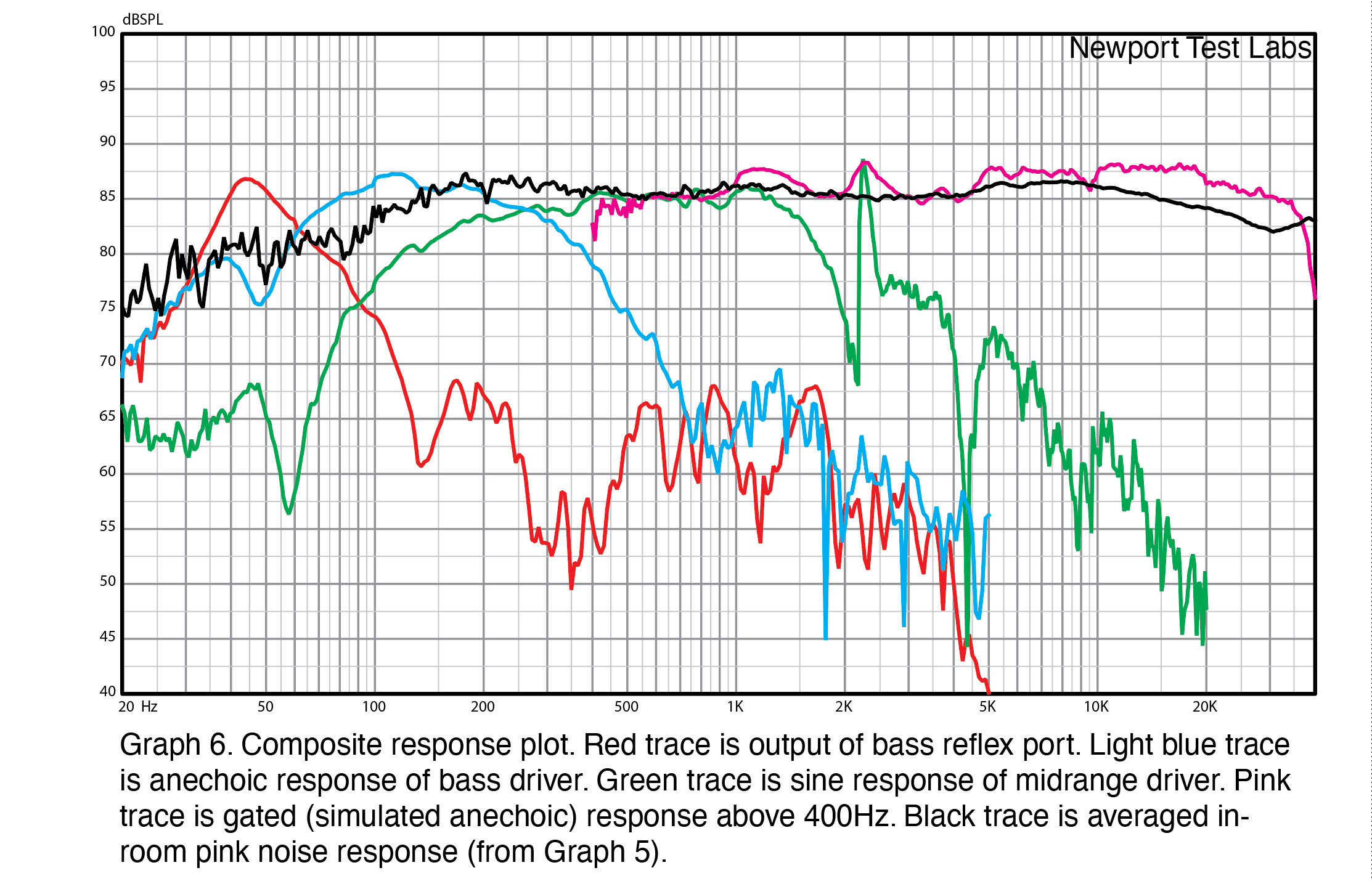
Graph 6 is a composite where all the traces shown on the previous graphs (except Graph 4) are shown on the same graph, except that in this one, the measurement limit for the midrange driver was extended upwards in order to look for the resonances I noticed on the impedance traces.
You can see that the response around 1–1.5kHz is affected because of additional energy from the bass drivers. The peak at 2.3kHz is clearly the result of a sharp and significant resonance in the midrange driver’s response. It’s certainly not something I would expect to see, not least because it lies well within the audio band, at around C#7–D7.
Newport Test Labs reported that when using its standard, stringent testing technique, it measured the sensitivity of the Sonus Faber Olympica Nova II as 86.5dBSPL at one metre for a 2.83Veq input. This is a little lower than Sonus Faber’s specification of 88dBSPL, but could be accounted for by differences in measurement techniques. Nonetheless, in light of it, I’d reiterate my earlier advice about the desirability of using a high-power, high-current amplifier to drive these speakers.
The Sonus Faber Olympica Nova II’s efficiency was a little lower than I would expect for a floor-standing loudspeaker, and that significant resonance at around 2.3kHz would suggest anyone auditioning the Nova IIs should listen carefully to see if there are any audible effects, though the flatness of the in-room frequency response would suggest that there won’t be.
Australian Hi-Fi is one of What Hi-Fi?’s sister titles from Down Under and Australia’s longest-running and most successful hi-fi magazines, having been in continuous publication since 1969. Now edited by What Hi-Fi?'s Becky Roberts, every issue is packed with authoritative reviews of hi-fi equipment ranging from portables to state-of-the-art audiophile systems (and everything in between), information on new product launches, and ‘how-to’ articles to help you get the best quality sound for your home. Click here for more information about Australian Hi-Fi, including links to buy individual digital editions and details on how best to subscribe.
-
nopiano Very thorough review! Interesting historical view of aperiodic design - new to me - though Jordan is not.Reply
Great to have objective measurements too, vital for good amplifier matching, amongst other things.
More from Australia please. -
Sliced Bread Really enjoying this new review approach. The technical measurements and more thorough discussion is a very welcome improvement to what was already a good format.Reply
Full thumbs up guys and gals!!!!
